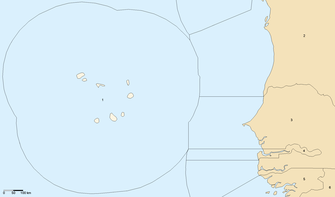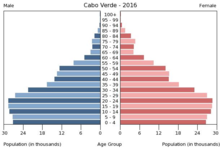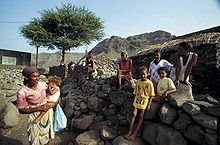Cape Verde
This is the sighted version that was marked on June 17, 2021. There is 1 pending change that needs to be sighted.
![]()
Cabo Verde is a redirect to this article. For other meanings, see Cabo Verde (disambiguation).
Template:Infobox State/Maintenance/NAME-German
Cape Verde [ˌkapˈvɛrdə] (officially Portuguese Cabo Verde [ˌkabuˈveɾdɨ], in German obsolete: "Islands of the Green Foothills") is an African island nation consisting of the Cape Verde Islands with nine inhabited islands in the Central Atlantic Ocean, 570 kilometres off the west coast of the African continent. The archipelago has a land area of 4033 km² and about 550,000 inhabitants. The capital is Praia.
The former Portuguese colony is now one of the most stable and prosperous countries in Africa.

Exclusive Economic Zone of Cape Verde
Geography
Location
The Republic of Cape Verde is located in the Central Atlantic off the west coast of the African continent. The archipelago consists of 15 islands and other small islets, nine of which are inhabited. A distinction is made between the northern islands above the wind (Ilhas de Barlavento) and the southern islands below the wind (Ilhas de Sotavento). The islands above the wind are Santo Antão, São Vicente, São Nicolau, Sal, Boa Vista and the uninhabited islands of Santa Luzia, Branco and Raso. The Sotavento group includes Maio, Santiago, Fogo and Brava, and the uninhabited archipelago of Ilhéus do Rombo.
fauna and flora
The vegetation of the Cape Verde Islands is semi-desert-like due to the aridity. Among other things, there are dry grasslands, in the eastern part the islands are also covered with large dunes or salt marshes (mangroves). In addition, there are some palm species such as the Canary Island date palm, which are adapted to the aridity.
The fauna on the islands is comparatively species-poor. Before human settlement, there were no mammals on the islands except for one species of bat. There are also a few small reptile species, for example geckos and skinks. Sea turtles occasionally lay their eggs on the beaches.
Geology
The archipelago of Cape Verde is of volcanic origin. The highest elevation of Cape Verde is the even volcanic cone of Pico do Fogo with 2829 meters height. In 1995 it erupted again after a 44-year dormant phase. Thereby the 1920 m high parasitic crater "Pequeno Fogo" was formed, at whose edges hot fumaroles are still active. This parasitic volcano was active again from 23 November 2014, spewing ash clouds and fire. Two towns and some other small settlements in the caldeira were destroyed by the erupting lava, which poured into the caldeira with three main flows. Volcanic activity ended on 8 February 2015. The islands to the northwest Santo Antão, São Vicente and São Nicolau, and Santiago are also young-volcanic and high-mountainous, while the eastern islands are much older, shallowly eroded except for some witness mountains, and with a limestone base. The following seamounts also belong to the archipelago: Seamount Nola (west of Santo Antãos), Seamount Boavista (east of Boa Vistas), Seamount Cape Verde (southeast of Boa Vistas), Seamount Maio (east of Maios) and Seamount Cadamosto (south of Bravas). Possibly the João Valente reef south of Boa Vista also belongs to the seamounts. There are no permanent rivers or streams on the islands except for the Ribeira da Torre and the Ribeira da Paúl (both on Santo Antão Island). In the interior of Boavista, the small freshwater lake Odjo d'Água exists all year round. In the rainy season, the otherwise dry valleys of the Ribeiras (= streams) often swell to torrents and destroy roads and paths, which then sometimes remain impassable for a long time.
Climate
The Cape Verde Islands have a mild oceanic climate similar to the Canary Islands. However, it is warmer and drier and is determined by the northeast trade wind. The climate is characterized by small temperature differences between day and night (mostly around 5 °C) and by relatively high humidity (around 70 %) throughout the year. Thus, daytime temperatures range between 23 and 30 °C all year round, with nighttime values around 18 °C in winter (January to April) and 24 °C in summer (August to October). The soil is very dry everywhere, and the average rainfall in the capital is around 250 mm per year, otherwise usually only between 100 and 200 mm. Most precipitation falls from August to November. The water temperatures of 22 to 27 °C make the country attractive for beach tourism.
| Praia | ||||||||||||||||||||||||||||||||||||||||||||||||
| Climate diagram | ||||||||||||||||||||||||||||||||||||||||||||||||
| ||||||||||||||||||||||||||||||||||||||||||||||||
| Monthly average temperatures and precipitation for Praia
Source: wetterkontor.de | ||||||||||||||||||||||||||||||||||||||||||||||||||||||||||||||||||||||||||||||||||||||||||||||||||||||||||||||||||||||||||||||||||||||||||||||||||||||||||||||||||||||||||||||||||||||||||||||||||||||||||||||||||||||||||||||||||||||||||||||||||||||||||||||||||||||||||||||||||||||||||
Population
Origin of the population
The Cape Verde Islands were uninhabited before their discovery and settlement by the Portuguese. From the intermingling of the cultures of European settlers and African slaves, a new Creoleculture was formed.
A 2010 study of the genetics of Cape Verde's population concluded that European genes accounted for 43 percent and African genes for 57 percent.
Demographics
The history of Cape Verde is marked by repeated waves of immigration from Portugal and Madeira, strong economic influence of the English and mass emigration in response to repeated famines. In 2010, an estimated 700,000 Cape Verdeans living in the diaspora were added to the archipelago's population of about 516,000 at the time. Because of the country's poverty, there are few immigrants, but a number of Nigerians (mostly traders) have settled in Praia in recent years.
A good half of the population is concentrated on the main island of Santiago.
| Population development (according to UN) | |
| Year | Population |
| 1950 | 178.000 |
| 1960 | 202.000 |
| 1970 | 269.000 |
| 1980 | 284.000 |
| 1990 | 338.000 |
| 2000 | 428.000 |
| 2010 | 493.000 |
| 2020 | 556.000 |
| 2030 | 610.000 |
According to the 2000 census, the gender ratio of females to males is 51.9 to 48.1 %. Due to famines and the resulting emigration, the generation born in the 1940s and 1950s is almost completely missing. About one third of the population is younger than 15 years. The average age in 2000 was 17.4 years, and population growth was 2.4% per year.
The average household has 4.6 members, 54% of the adult population describe themselves as single, 24% live in partnership without being married, and 16% are married. Three percent live separately or are divorced. This can be attributed to the fact that Portuguese law did not allow marriage among slaves or between slaves and freemen. This gave rise to a variety of forms of cohabitation in Creole societies that have survived to the present day.
The prospect of a better life attracts the young rural population to the cities or near the main roads. Today, 54% already belong to the urban population.
Cities
→ Main article: List of cities in Cape Verde
The only major city is the capital Praia. Only a few cities reach more than 10,000 inhabitants. These figures refer only to the core city and not the entire administrative area of the city (municipality).
| Cape Verde's largest cities according to the 2010 census: | |||
| City | Inhabitants | District | Island |
| Praia | 127.800 | Praia | Santiago |
| Mindelo | 70.500 | São Vicente | São Vicente |
| Espargos | 17.100 | Sal | Sal |
| Assomada | 12.000 | Santa Catarina | Santiago |
| Porto Novo | 9.400 | Porto Novo | Santo Antão |
| Pedra Badejo | 9.300 | Santa Cruz | Santiago |
| Santa Maria | 9.300 | Sal | Sal |
| São Filipe | 8.100 | São Filipe | Fogo |
| Tarrafal | 6.200 | Tarrafal | Santiago |
| Sal Rei | 5.400 | Boa Vista | Boa Vista |
Languages
The official language of Cape Verde is Portuguese; the national language is Cape Verdean Creole (Krioulo), which has several variants. The greatest differences are between the creole of Santiago and that of Santo Antão; they can go as far as mutual incomprehensibility. There are great similarities between the creole of Santiago and that of Guinea-Bissau. There is a process of decreolization, especially among the younger generation, due to increased education and the use of Portuguese-language media.
The government is striving to make Krioulo the official language. The regulations of ALUPEC have been agreed upon as the officially recognized spelling. French and English are learned by parts of the younger population at school.
Religion
Cape Verdeans are in the majority Roman Catholic (more than 90%). Other Christian denominations are also present in Cape Verde, notably the Protestant Church of the Nazarene, Seventh-day Adventists, the Church of Jesus Christ of Latter-day Saints (Mormons), Jehovah's Witnesses, Pentecostal churches and other Adventists. There are small minorities of Muslims and Bahai. The Universal Church of the Kingdom of God also has adherents in Cape Verde. Freedom of religion is guaranteed by the constitution and also respected by the government. There are good relations between the different faiths.
Education
Primary education is compulsory for children aged 6 to 14 and free for 6 to 12 year olds. Textbooks are available for 90 % of school children. 83 % of teachers have completed teacher training. Many pupils and some teachers speak Creole at home and do not have a perfect command of Portuguese. Expenditure on school materials, books and meals is not sufficient; there is a high repetition rate for some grades.
In addition to the primary schools, there are secondary schools in Praia, Mindelo and others, which lead to university entrance qualifications. In 2006, the Universidade de Cabo Verde was founded, incorporating some technical colleges, and is developing rapidly. There is also the private Universidade Jean Piaget, a branch of the Instituto Jean Piaget in Portugal.
The literacy rate in 2019 was 86.8% of the population. The average length of school attendance for those over 25 years of age is 6.3 years. The expected duration of school attendance for the new generation of pupils is twice as high, at 12.7 years.
Health
Life expectancy at birth is one of the highest in Africa. In 2019, it was 73 years (men: 69.5 years, women: 76.2 years). There are 49 doctors per 100,000 inhabitants.

Population pyramid Cape Verde 2016

Family with children in Tarrafal on Santiago Island
Questions and Answers
Q: What is the official name of Cape Verde?
A: The official name of Cape Verde is the Republic of Cabo Verde.
Q: Where is Cape Verde located?
A: Cape Verde is an island country in Africa, located 570 km (354 mi) off the coast of Western Africa in the Atlantic Ocean.
Q: How large is Cape Verde?
A: The islands cover a combined area of slightly over 4,000 km2 (1,500 sq mi).
Q: What group does Cape Verde belong to?
A: Cape Verde belongs to Macaronesia's group of islands.
Q: How were the islands formed?
A: The islands have a volcanic origin.
Q: Is Portuguese spoken in Cape Verde?
A: Yes, Portuguese is spoken in Cape Verde.
Search within the encyclopedia